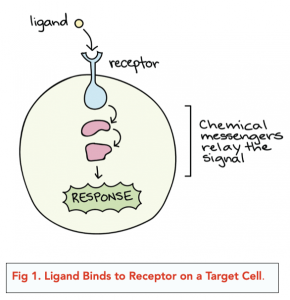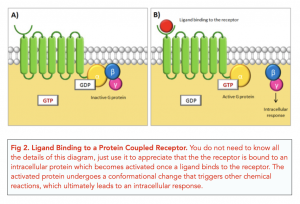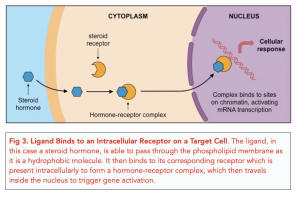Signalling Across Cell Membranes (A-level Biology)
Signalling Across Cell Membranes
We have previously established that the cell surface membrane is essential for cells to communicate with each other and their environment. Glycoproteins and glycolipids form receptors on the cell surface membrane, which are able to receive signals, such as hormones, from neighbouring cells or from the environment. This is then relayed to the inside of the cell to initiate specific cellular responses related to these messages.
Cell Signalling via ligands and receptors
- Communication across cells usually occur via chemical signals. These chemical signals, also known as ligands, are excreted by the sending cell into the extracellular space.
- The ligand will bind to a target cell which has a receptor that recognises the ligand. The ligand is intended for a target cell, which is able to receive this signal as it has a receptor that the ligand can specifically recognise and bind to.
- The binding of the ligand to the receptor causes an intracellular reaction. When the ligand binds to its corresponding receptor, it triggers a cascade of reactions in the cell that ultimately leads to a change within the cell. This resulting intracellular reaction can be small, such as activation of a gene, or large, such as inducing cell division.
- There can be multiple ligands being received by a cell at once. Most cells have multiple receptors, therefore, they can be receiving multiple ligands at once, each of which can trigger different intracellular reactions.

Types of ligands and receptors
Types of Ligands
- Some ligands are polar molecules. They only bind to the extracellular receptors on the cell surface membrane as they cannot cross the phospholipid bilayer. Examples include peptide hormones such as insulin.
- Some ligands are hydrophobic molecules. They can pass through the cell membrane and bind to intracellular receptors. Examples include steroid hormones such as testosterone and oestrogen.
Types of Receptors
- Some receptors sit extracellularly. Some receptors such as glycoproteins and glycolipids are anchored into the cell membrane. Their ligand-binding region (also called “domain”) remains extracellularly so that the ligand does not need to pass through the plasma membrane in order to bind to the receptor. Some extracellular receptors are coupled with another signalling protein that sits intracellularly. When a ligand binds to the extracellular domain of the receptor, it causes a conformational change in the intracellular protein the receptor is bound to, and this protein can then activate other signalling molecules within the cell to trigger further intracellular reactions.

- Some receptors sit intracellularly. Intracellular receptors are usually present in the cytoplasm or nucleus. When their ligand enters the cell and binds to them, it causes the intracellular receptor to change shape and form a hormone-receptor complex. This allows the complex to enter the nucleus (if it was not there previously) and cause a change in gene activity.

Signalling across cell membranes refers to the process by which cells communicate with each other by sending and receiving signals. This communication is essential for maintaining the proper functioning of cells and tissues, and is used to coordinate various physiological processes.
Cells communicate with each other through a variety of signaling molecules, such as hormones, neurotransmitters, and growth factors. These molecules can diffuse through the lipid bilayer of the cell membrane and bind to specific receptors on the target cell, triggering a response.
Cell membrane receptors play a crucial role in signaling. They act as gatekeepers, allowing signaling molecules to enter the cell and triggering a response. Different types of receptors have different structures and respond to different signaling molecules, allowing cells to distinguish between different signals.
Ligand-gated ion channels are receptors that allow ions (such as calcium or potassium) to flow into or out of the cell in response to a signaling molecule. G protein-coupled receptors, on the other hand, are receptors that activate G proteins, which then trigger a cascade of signaling events within the cell.
Second messengers are molecules that are produced within the cell in response to a signaling molecule. They help to amplify the signal and coordinate the response of the cell. Examples of second messengers include cyclic AMP (cAMP), inositol triphosphate (IP3), and diacylglycerol (DAG).
Signaling pathways regulate cell functions by controlling the activities of enzymes, ion channels, and other proteins within the cell. By controlling these activities, signaling pathways can alter the behavior of cells, including processes such as cell division, growth, and differentiation.
Signaling is a critical aspect of health and disease, as disruptions in signaling pathways can lead to a variety of pathological conditions, including cancer, autoimmune diseases, and neurodegenerative diseases. Understanding the mechanisms of signaling across cell membranes is therefore essential for the development of new treatments for these and other diseases.





Still got a question? Leave a comment
Leave a comment